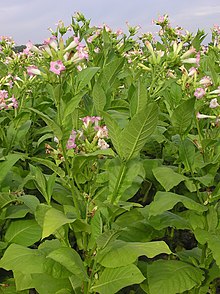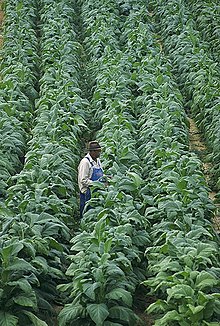Green Tobacco Sickness

As Green Tobacco Sickness ( GTS , English for example, for green tobacco disease ) is a complex disease symptoms is referred to, which by contact with tobacco plants is triggered. It is a type of nicotine poisoning . The nicotine of the plant dissolved in water gets through the skin into the circulation and leads to various symptoms. Workers on tobacco plantations are primarily affected.
The disease can lead to various symptoms such as nausea and dizziness, but also to fluctuations in blood pressure and heart rate. Children and newly hired workers are particularly at risk . Despite simple preventive measures, a high proportion of workers are affected. So far, the GTS has been considered insufficiently researched.
State of research and dissemination
The GTS was first described in 1970. Nevertheless, so far only a few studies have appeared on the subject. Knowledge about the disease is therefore comparatively low. The development of symptoms in children, long-term consequences, the dependence of the occurrence of GTS on the climate and season, as well as treatment options and prevention strategies, have been little or insufficient research.
Due to the inadequate state of research, it is also unclear how high the number of those affected is. Studies of tobacco fields in the US showed that up to a quarter of workers are affected.
trigger
Green Tobacco Sickness is triggered by direct contact with the leaves of the tobacco plant. Especially with so-called topping , in which the flower of the plant is removed in order to increase the size of the tobacco leaves and the nicotine content and during the harvest, the workers come into contact with the plants. When these are damp - for example from rain or dew - the liquid on the surface of the leaves contains dissolved nicotine. Through the unprotected skin, the nicotine diffuses, enters the person's body and leads to the symptoms associated with the disease.
Especially when the leaves are damp, the risk of suffering from the symptoms of GTS increases. The moisture on the tobacco leaves contains up to 9 mg of dissolved nicotine per 100 ml, which corresponds to the nicotine content of about six cigarettes. On wet days, workers are exposed to an average of 600 ml of dew. A high nicotine concentration can then be detected, for example, in the sweat of the workers.
The absorption of nicotine is influenced by several factors. Exercise and high ambient temperature can increase the amount of nicotine ingested, as both factors increase blood flow. Depending on the type of tobacco, a different intensity of management is necessary, which can be accompanied by increased contact, which in turn increases the risk of GTS.
The tobacco plant as such is the source of the health hazard and not external factors such as the use of pesticides . Something similar can be found in coca and opium cultivation , for example .
Disease symptoms
Symptoms vary from person to person and include nausea and vomiting, headache, muscle weakness, and dizziness. Sleep and eating disorders are also reported. As a rule, however, GTS is not fatal. Above all, repeated vomiting can lead to dehydration , which in turn can lead to death at high temperatures, for example from heat stroke . Significant parallels between the symptoms and other diseases such as pesticide poisoning make diagnosis difficult or lead to misdiagnosis.
The symptoms can occur during or after working with tobacco plants and usually last between 12 and 48 hours if there is no further contact with tobacco plants. Drinking water can help relieve symptoms. After long-term exposure to tobacco plants, the development of nicotine tolerance could be demonstrated. The development of this is also favored by the further intake through nicotine, for example also through nicotine chewing gums or patches .
Children are less likely to develop tolerance than adults. Children are also generally more affected due to their small body size and thus relatively higher nicotine concentration, lack of tolerance and greater ignorance about the disease. The same assumptions apply to new workers.
Prevention
With comparatively simple means, the consumption of nicotine can at least be reduced as part of a GTS. First of all, this includes wearing protective clothing such as raincoats and water-repellent gloves. It must be noted that handling contaminated clothing must also be practiced and that clothing must be disposed of after work. Washing your body right after work can reduce the amount of nicotine on your skin by up to 96 percent. If possible, you should wait until the leaves have dried before continuing work after precipitation. Furthermore, workers should be educated about the disease itself, risk factors and preventive measures.
Individual evidence
- ^ A b Green Tobacco Sickness. What you need to know (English) . Philip Morris International. Archived from the original on May 15, 2015. Info: The archive link was automatically inserted and has not yet been checked. Please check the original and archive link according to the instructions and then remove this notice. Retrieved April 22, 2016.
- ↑ a b c d e f R. H. McKnight, HA Spiller: Green tobacco sickness in children and adolescents. In: Public health reports (Washington, DC: 1974). Volume 120, number 6, 2005 Nov-Dec, pp. 602-605, PMID 16350329 , PMC 1497768 (free full text).
- ^ A b Green Tobacco Sickness. Recommended Practices . United States Department of Labor. Retrieved April 22, 2016.
- ↑ Green Tobacco Sickness. Overview (English) . Center for Disease Control and Prevention. Retrieved April 22, 2016.
